Multifunctionality Analysis of Structural Supercapacitors— A Review
Abstract
1. Introduction
- (a)
- Integrated SSC: In the integrated configuration, SSCs are developed by sandwiching monofunctional SCs between two composite layers of structural reinforcement laminates (Figure 2a) [17]. SSCs could be created by packing monofunctional SCs inside structural reinforcement layers made of CFs [8], glass fibers (GFs) [18], or aramid fibers [19]. The most common design is composed of CF electrodes separated by a separator layer connected by an ion-conducting electrolyte [20]. While such a device displays electrical storage and load-bearing functionality, true multifunctionality is not given, since the respective parts of the SSC do not provide multifunctional properties. In addition to CFRPs, other types of reinforcement have been reported in the literature, such as the integration of SCs into a honeycomb structure with the aim to further improve the lightweight properties [21].
- (b)
- Laminated SSC: An SSC with a higher integration level includes the use of CF mats acting simultaneously as electrode and reinforcement. For this certain design, a polymer-based ionic liquid functions as both composite matrix and the electrolyte material (Figure 2b).
2. Materials and Methods
2.1. Data Sources and Selection
2.2. Assessment of Multifunctionality
3. Component Analysis
3.1. Electrode Material
3.1.1. Increasing Carbon Fiber Porosity
3.1.2. Activation of Carbon Fibers after Fabrication
3.1.3. Heteroatom Doping of Carbon Fibers
3.1.4. Surface Deposition of Carbon Fibers (Hybrid Electrodes)
3.1.5. Summary of Electrode Modification Methods
3.2. Current Collector
3.3. Electrolyte
3.3.1. Solid-State Electrolytes with Inorganic Fillers
3.3.2. Layered Solid-State Electrolytes
3.3.3. Solid-State Electrolytes with Metal–Organic Frameworks
3.3.4. Solid State Electrolytes with Bicontinuous Phase Structure
3.3.5. Summary of Different Types of Solid-State Electrolytes
3.4. Separator
3.4.1. Glass Fiber-Based Separators
3.4.2. Polymer-Based Separators
3.4.3. Gel and Solid Polymer-Based Electrolyte Separators
3.4.4. Polymer–Ceramic-Based Separators
3.4.5. Ceramic Separators
3.4.6. Cellulose-Based Separators
3.4.7. Summary of Different Approaches for Separators Used in SSCs
4. Multifunctionality Analysis in Current SSCs and Future Work
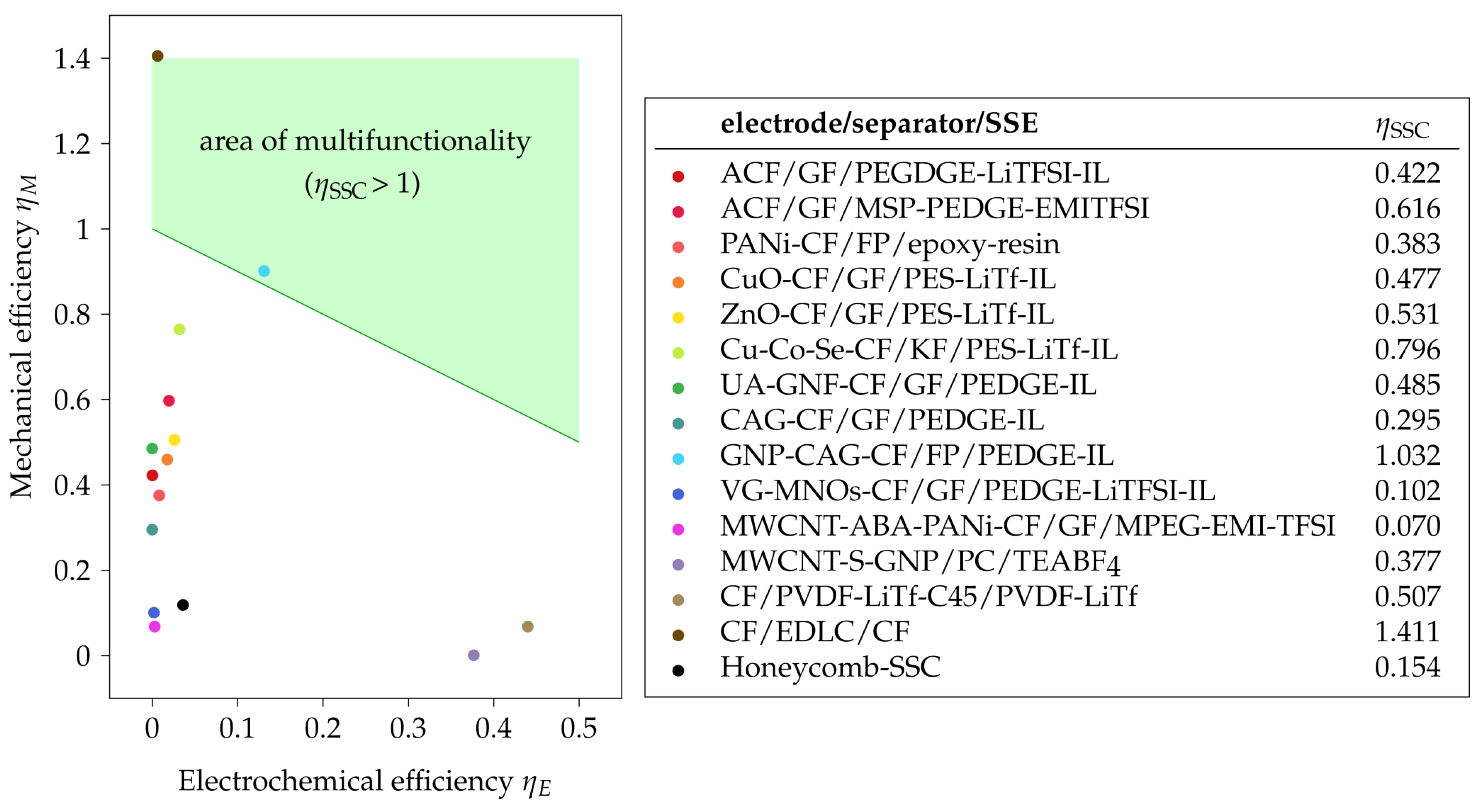
5. Conclusions
Author Contributions
Funding
Data Availability Statement
Acknowledgments
Conflicts of Interest
Abbreviations
| EDLC | Electric double-layer capacitor |
| EES | Electrical energy storage |
| ESD | Energy storage devices |
| CAG | Carbon aerogel |
| CF | Carbon fiber |
| CFRP | Carbon fiber reinforced polymers |
| CNT | Carbon nanotube |
| CP | Conducting polymer |
| FRC | Fiber reinforced composites |
| GF | Glass fibers |
| GNP | Graphene nanoplatelets |
| GO | graphene oxide |
| HE | Hybrid electrolyte |
| ISE | Inorganic solid electrolyte |
| LiB | Lithium-ion battery |
| MESC | Multifunctional energy storage composite |
| MOF | Metal–organic framework |
| Ni | Nickel |
| SC | Supercapacitor |
| SPE | Solid polymer electrolyte |
| SSA | Specific surface area |
| SSC | Structural supercapacitor |
| SSE | Solid-state electrolyte |
| UD | Unidirectional |
Appendix A. Data Tables
| Type of Modification | Untreated SSA * (m2/g) | Treated SSA * (m2/g) | Redox Activity | Influence on Stiffness of the CF * | Influence on Interfacial Shear Strength * | Ref. | |
|---|---|---|---|---|---|---|---|
| Thermo-chemical activation | CF/KOH | 0.331 | 32.8 | No | Slight overall increase | n.a. | [168] |
| Wet chemical activation | CF/KMnO4/H2SO4 | 6 | 92 | No | Slight overall decrease | Increase | [54] |
| Electrochemical activation | N/O-enriched carbon cloth | 419.85 | 468.59 | Yes | Decrease in tensile strength | Increase | [57] |
| Physical activation | Plasma-treated active carbon fibers | 1500 | 2103 | Yes | Overall increase [88] | n.a. | [61] |
| Heteroatom-doping | Boron and oxygen co-doped carbon nanofibers | 461.5 | 725.7 | Yes | Increase in tensile strength with a decrease in young’s modulus [90] | n.a. | [89] |
| Introduction of pores during fabrication | Carbonization and activation of carbon nanofibers in CO2 | 294 | 705 | Yes | Overall decrease | Increase | [49] |
| Sulfonated tetrafluoroethylene based fluoropolymer-copolymer as pore-forming agent for carbon nanofibers | 339 | 1614 | No | Overall decrease | Increase | [50] | |
| Surface deposition of active materials | CF/CNT sizing | 0.21 | 33.4 | No | Decrease in tensile strength | Increase [74] | [91] |
| CF/CNT grafting | 0.21 | 45.8 | No | No significant effects on modulus [74] | |||
| CF/GNP | 0.33 | n.a. | No | No significant effects | Increase | [76] | |
| CF/conducting polymers | n.a. | n.a. | Yes | No significant effects | No significant effects | [77] | |
| CF/Cu-Co-Se nanowires | 0.62 | 195.65 | Yes | n.a. | Increase | [84] | |
| CF/CAG | 0.21 | 80.7 | No | n.a. | Increase | [86] | |
| Combination | CF/CAG/GNP | 0.25 | 223 | No | n.a. | Increase | [87] |
| Type of Electrolyte | Composition | Ionic Conductivity * (mS/cm) | Young’s Modulus * (MPa) | Tensile Strength * (MPa) | Ref. |
|---|---|---|---|---|---|
| Epoxy resin with active fillers | PEGDGE/TBAPF6/PC | 0.012 | 5.46 | n.a. | [95] |
| PEGDGE/LiTFSI/PC | 0.017 | 10.2 | n.a. | ||
| PEGDGE/NaClO4/PC | 0.018 | 11.3 | n.a. | ||
| PEGDGE/EMITFSI | 0.020 | 11.3 | n.a. | ||
| DGEBA/LiTFSI/PC | 0.138 | 0.922 | n.a. | ||
| PEGDGE/EMITFSI | 0.176 | 3.83 | n.a. | ||
| Epoxy Resin/[PVDF/LiTf (25:75)] | 10.8 | n.a. | 80 | [134] | |
| Epoxy Resin/[PVDF/LiTf (25:75)] | 24.8 | n.a. | 55 | ||
| Thermoplastic resin with active filler | PVDF/LiTf (25:75) | 39.6 | n.a. | 66 | [134] |
| 28.9 | n.a. | 136 | |||
| PET/LiClO4 (90:10) | 0.001 | 2100 | n.a. | [131] | |
| Ionic liquid with active fillers | MVR444/EMIM-TFSI/LiTFSI | 0.04 | 190 | n.a. | [124] |
| MVR444/EMIM-TFSI/LiTFSI | 0.23 | 190 | n.a. | ||
| MTM57/EMIM-TFSI/LiTFSI | 0.007 | 810 | n.a. | ||
| MTM57/EMIM-TFSI/LiTFSI | 0.8 | 180 | n.a. | ||
| Ionic liquid with active and passive fillers | DGEBA/LiTFSI/BMIM-TFSI | ~0.1 | 500 | n.a. | [132] |
| DGEBA/LiTFSI/BMIM-TFSI/Al2O4 (5 vol%) | ~0.29 | 1000 | n.a. | ||
| 1Layered electrolyte designs | hierarchical sandwich | 0.023 | 11.3 | n.a. | [121] |
| Type of Separator | Separator Material | Ionic Conductivity * (mS/cm) | Young’s Modulus * (GPa) | Strength * (MPa) | Ref. |
|---|---|---|---|---|---|
| Glass fibre | Glass fibre | 1.13 | 21 | 325 | [135] |
| Polymer | RF/PLA | 110 | 0.3271 | 15.2 | [161] |
| Solid polymer electrolyte | 0.2 | 26 | 350 | [139,160] | |
| Ceramic | n.a. | 1.2 | 65 | [145] | |
| 13.5 | n.a. | 30 | [162] | ||
| Cellulose | MCC/AMIM-Cl | 298.6 | 5.43 | 71.71 | [140,156] |
| SSC Assembly | Specific Capacitance * (F/g) | Power Density * (W/kg) | Energy Density (mWh/kg) | Modulus 1 (GPa) | Strength 2,* (MPa) | Ref. |
|---|---|---|---|---|---|---|
| ACF/GF/PEGDGE-LiTFSI-IL | 0.052 | 2.68 | 1.43 | = 18.04 | n.a. | [45] |
| ACF/GF/MSP-PEDGE-EMITFSI | n.a. | 34.4 | 117.7 | = 1.75 | = 38.2 | [76] |
| PANi-CF/FP/epoxy-resin | 0.022 | 58.4 | 49.4 | = 1.1 | = 6.3 | [165] |
| CuO-CF/GF/PES-LiTf-IL | 6.75 | 12.57 | 106.04 | = 19.62 | = 251.76 | [166] |
| ZnO-CF/GF/PES-LiTf-IL | 18.82 | 19.87 | 156.21 | = 21.59 | = 325.82 | [135] |
| Cu-Co-Se-CF/KF/PES-LiTf-IL | 28.63 | 36.65 | 191.64 | = 32.65 | = 488.89 | [84] |
| UA-GNF-CF/GF/PEDGE-IL | 0.048 | 0.788 | 0.067 | = 20.72 | = ~90 | [167] |
| CAG-CF/GF/PEDGE/IL | 0.071 | 0.033 | 0.099 | = 0.895 | = 8.71 | [86] |
| GNP-CAG-CF/FP/DGEBA- | 0.354 | 107.8 | 786.05 | = 2.64 | = 8.70 | [87] |
| VG-MnO2-CF/GF/PEGDGE-LiTFSI-IL | 240 | 2.21 | 12.2 | = 4.3 ** | = 87 ** | [94] |
| MWCNT-ABA-PANi-CF/GF/MPEG-EMI-TFSI | 0.125 | n.a. | 17.4 | = 2.9 3 | = 21 3 | [78] |
| MWCNT-S-GNP/PC/ | 12.2 | 82.2 | 2260 | = 0.037 3 | = 0.24 3 | [163] |
| CF/PVDF-LiTf-C45/PVDF-LiTf | 69.68 | n.a. | 2640 | = 2.9 ** | = 80 | [134] |
| CF/EDLC(CNT fiber/thermoplastic-PYR14-TFSI)/CF | 0.088 | 30 | 37.5 | = 60 3 | = 153 3 | [8] |
| Honeycomb-SSC | 158.7 | 11.09 | 216.7 | = 5.07 3 | = 413.9 3 | [21] |
References
- Boulanger, A.G.; Chu, A.C.; Maxx, S.; Waltz, D.L. Vehicle Electrification: Status and Issues. Proc. IEEE 2011, 99, 1116–1138. [Google Scholar] [CrossRef]
- Fic, K.; Meller, M.; Menzel, J.; Frackowiak, E. Around the Thermodynamic Limitations of Supercapacitors Operating in Aqueous Electrolytes. Electrochim. Acta 2016, 206, 496–503. [Google Scholar] [CrossRef]
- Shaffer, B.; Auffhammer, M.; Samaras, C. Make Electric Vehicles Lighter to Maximize Climate and Safety Benefits. Nature 2021, 598, 254–256. [Google Scholar] [CrossRef]
- Spotlight: Solving Challenges. In Energy Storage; Office of Technology Transitions, U.S.: Washington, DC, USA, 2018.
- Pereira, T.; Guo, Z.; Nieh, S.; Arias, J.; Hahn, H.T. Energy Storage Structural Composites: A Review. J. Compos. Mater. 2009, 43, 549–560. [Google Scholar] [CrossRef]
- Kar, K.K. (Ed.) Materials Science. In Handbook of Nanocomposite Supercapacitor Materials I: Characteristics; Springer Series; Springer International Publishing: Cham, Switzerland, 2020; Volume 300. [Google Scholar] [CrossRef]
- Khan, A.; Saxena, K.K. A Review on Enhancement of Mechanical Properties of Fiber Reinforcement Polymer Composite under Different Loading Rates. Mater. Today Proc. 2022, 56, 2316–2322. [Google Scholar] [CrossRef]
- Senokos, E.; Ou, Y.; Torres, J.J.; Sket, F.; González, C.; Marcilla, R.; Vilatela, J.J. Energy Storage in Structural Composites by Introducing CNT Fiber/Polymer Electrolyte Interleaves. Sci. Rep. 2018, 8, 3407. [Google Scholar] [CrossRef] [PubMed]
- Luo, X.; Chung, D. Carbon-fiber/polymer-matrix composites as capacitors. Compos. Sci. Technol. 2001, 61, 885–888. [Google Scholar] [CrossRef]
- Snyder, J.; O’Brien, D.; Baechle, D.; Mattson, D.; Wetzel, E. Structural Composite Capacitors, Supercapacitors, and Batteries for U.S. Army Applications. In Proceedings of the ASME 2008 Conference on Smart Materials, Adaptive Structures and Intelligent Systems, Ellicott City, MI, USA, 28–30 October 2008; Volume 1, p. 10. [Google Scholar] [CrossRef]
- Christodoulou, L.; Venables, J.D. Multifunctional material systems: The first generation. JOM 2003, 55, 39–45. [Google Scholar] [CrossRef]
- Latham, K.G.; Edathil, A.A.; Rezaei, B.; Liu, S.; Nguyen, S.; Keller, S.S.; Torrisi, F.; Greenhalgh, E.S.; Titirici, M.M. Challenges and opportunities in free-standing supercapacitors research. APL Mater. 2022, 10, 110903. [Google Scholar] [CrossRef]
- Montano Rejas, Z.; Keimer, R.; Geier, S.; Lange, M.; Mierheim, O.; Petersen, J.; Pototzky, A.; Wolff, J. Design and manufacturing of a multifunctional highly integrated satellite panel structure. In Proceedings of the ECSSMET 2021, Virtual, 23–25 March 2021; Hühne, C., Henriksen, T., Tourneau, P.Y., Eds.; [Google Scholar]
- Yao, L.; Zheng, K.; Koripally, N.; Eedugurala, N.; Azoulay, J.D.; Zhang, X.; Ng, T.N. Structural pseudocapacitors with reinforced interfaces to increase multifunctional efficiency. Sci. Adv. 2023, 9, eadh0069. [Google Scholar] [CrossRef] [PubMed]
- Shen, Z.; Zhou, H. Mechanical and electrical behavior of carbon fiber structural capacitors: Effects of delamination and interlaminar damage. Compos. Struct. 2017, 166, 38–48. [Google Scholar] [CrossRef]
- Valkova, M.; Anthony, D.B.; Kucernak, A.; Shaffer, M.; Greenhalgh, E.S. Predicting the mechanical behaviour of structural supercapacitor composites. Compos. Part A Appl. Sci. Manuf. 2022, 156, 106860. [Google Scholar] [CrossRef]
- Zhou, H.; Li, H.; Li, L.; Liu, T.; Chen, G.; Zhu, Y.; Zhou, L.; Huang, H. Structural Composite Energy Storage Devices—A Review. Mater. Today Energy 2022, 24, 100924. [Google Scholar] [CrossRef]
- Rana, M.; Ou, Y.; Meng, C.; Sket, F.; González, C.; Vilatela, J.J. Damage-Tolerant, Laminated Structural Supercapacitor Composites Enabled by Integration of Carbon Nanotube Fibres. Multifunct. Mater. 2020, 3, 015001. [Google Scholar] [CrossRef]
- Sun, J.; Gargitter, V.; Pei, S.; Wang, T.; Yan, Y.; Advani, S.G.; Wang, L.; Chou, T.W. Mechanical and Electrochemical Performance of Hybrid Laminated Structural Composites with Carbon Fiber/ Solid Electrolyte Supercapacitor Interleaves. Compos. Sci. Technol. 2020, 196, 108234. [Google Scholar] [CrossRef]
- Pernice, M.F.; Qi, G.; Senokos, E.; Anthony, D.B.; Nguyen, S.; Valkova, M.; Greenhalgh, E.S.; Shaffer, M.S.P.; Kucernak, A.R.J. Mechanical, Electrochemical and Multifunctional Performance of a CFRP/Carbon Aerogel Structural Supercapacitor and Its Corresponding Monofunctional Equivalents. Multifunct. Mater. 2022, 5, 025002. [Google Scholar] [CrossRef]
- Reece, R.; Lekakou, C.; Smith, P.A. A High-Performance Structural Supercapacitor. ACS Appl. Mater. Interfaces 2020, 12, 25683–25692. [Google Scholar] [CrossRef]
- Ashby, M. Multi-objective optimization in material design and selection. Acta Mater. 2000, 48, 359–369. [Google Scholar] [CrossRef]
- Snyder, J.; O’Brien, D.; Wetzel, E. Structural Batteries, Capacitors and Supercapacitors. In Handbook of Solid State Batteries; World Scientific: Singapore, 2015; Chapter 19; pp. 657–699. [Google Scholar] [CrossRef]
- Snyder, J.; Gienger, E.; Wetzel, E. Performance Metrics for Structural Composites with Electrochemical Multifunctionality. J. Compos. Mater. 2015, 49, 1835–1848. [Google Scholar] [CrossRef]
- Drechsler, K.; Heine, M.; Mitschang, P. 12.1 Carbon Fiber Reinforced Polymers*. In Industrial Carbon and Graphite Materials, 1st ed.; Jäger, H., Frohs, W., Eds.; Wiley: Hoboken, NJ, USA, 2021; Volume I, pp. 697–739. [Google Scholar] [CrossRef]
- Forouzandeh, P.; Kumaravel, V.; Pillai, S.C. Electrode Materials for Supercapacitors: A Review of Recent Advances. Catalysts 2020, 10, 969. [Google Scholar] [CrossRef]
- He, X.; Ma, H.; Wang, J.; Xie, Y.; Xiao, N.; Qiu, J. Porous Carbon Nanosheets from Coal Tar for High-Performance Supercapacitors. J. Power Sources 2017, 357, 41–46. [Google Scholar] [CrossRef]
- Qi, F.; Xia, Z.; Sun, R.; Sun, X.; Xu, X.; Wei, W.; Wang, S.; Sun, G. Graphitization Induced by KOH Etching for the Fabrication of Hierarchical Porous Graphitic Carbon Sheets for High Performance Supercapacitors. J. Mater. Chem. A 2018, 6, 14170–14177. [Google Scholar] [CrossRef]
- Ardizzone, S.; Fregonara, G.; Trasatti, S. “Inner” and “Outer” Active Surface of RuO2 Electrodes. Electrochim. Acta 1990, 35, 263–267. [Google Scholar] [CrossRef]
- Zheng, J.P.; Cygan, P.J.; Jow, T.R. Hydrous Ruthenium Oxide as an Electrode Material for Electrochemical Capacitors. J. Electrochem. Soc. 1995, 142, 2699–2703. [Google Scholar] [CrossRef]
- Lee, H.Y.; Goodenough, J. Supercapacitor Behavior with KCl Electrolyte. J. Solid State Chem. 1999, 144, 220–223. [Google Scholar] [CrossRef]
- Brousse, T.; Toupin, M.; Dugas, R.; Athouël, L.; Crosnier, O.; Bélanger, D. Crystalline MnO2 as Possible Alternatives to Amorphous Compounds in Electrochemical Supercapacitors. J. Electrochem. Soc. 2006, 153, A2171. [Google Scholar] [CrossRef]
- Zhu, G.; He, Z.; Chen, J.; Zhao, J.; Feng, X.; Ma, Y.; Fan, Q.; Wang, L.; Huang, W. Highly Conductive Three-Dimensional MnO2–Carbon Nanotube–Graphene–Ni Hybrid Foam as a Binder-Free Supercapacitor Electrode. Nanoscale 2014, 6, 1079–1085. [Google Scholar] [CrossRef]
- Li, L.; Chen, L.; Qian, W.; Xie, F.; Dong, C. Directly Grown Multiwall Carbon Nanotube and Hydrothermal MnO2 Composite for High-Performance Supercapacitor Electrodes. Nanomaterials 2019, 9, 703. [Google Scholar] [CrossRef]
- Alvarez, N.; Ochmann, T.; Kienzle, N.; Ruff, B.; Haase, M.; Hopkins, T.; Pixley, S.; Mast, D.; Schulz, M.; Shanov, V. Polymer Coating of Carbon Nanotube Fibers for Electric Microcables. Nanomaterials 2014, 4, 879–893. [Google Scholar] [CrossRef]
- Foroughi, J.; Spinks, G. Carbon Nanotube and Graphene Fiber Artificial Muscles. Nanoscale Adv. 2019, 1, 4592–4614. [Google Scholar] [CrossRef]
- Tian, J.; Cui, N.; Chen, P.; Guo, K.; Chen, X. High-Performance Wearable Supercapacitors Based on PANI/N-CNT@CNT Fiber with a Designed Hierarchical Core-Sheath Structure. J. Mater. Chem. A 2021, 9, 20635–20644. [Google Scholar] [CrossRef]
- Cheng, H.; Li, Q.; Zhu, L.; Chen, S. Graphene Fiber-Based Wearable Supercapacitors: Recent Advances in Design, Construction, and Application. Small Methods 2021, 5, 2100502. [Google Scholar] [CrossRef] [PubMed]
- Serrapede, M.; Seller, F.; Zaccagnini, P.; Castellino, M.; Roppolo, I.; Catania, F.; Tata, J.; Serra, T.; Bianco, S.; Lamberti, A. Tunable all-solid-state wire-shaped high power device based on carbon nanotubes yarn. Carbon 2023, 213, 118283. [Google Scholar] [CrossRef]
- Lu, W.; Zu, M.; Byun, J.H.; Kim, B.S.; Chou, T.W. State of the Art of Carbon Nanotube Fibers: Opportunities and Challenges. Adv. Mater. 2012, 24, 1805–1833. [Google Scholar] [CrossRef] [PubMed]
- Xu, Z.; Gao, C. Graphene Fiber: A New Trend in Carbon Fibers. Mater. Today 2015, 18, 480–492. [Google Scholar] [CrossRef]
- Chen, S.; Qiu, L.; Cheng, H.M. Carbon-Based Fibers for Advanced Electrochemical Energy Storage Devices. Chem. Rev. 2020, 120, 2811–2878. [Google Scholar] [CrossRef]
- Li, Q.; Zhu, Y.Q.; Eichhorn, S.J. Structural Supercapacitors Using a Solid Resin Electrolyte with Carbonized Electrospun Cellulose/Carbon Nanotube Electrodes. J. Mater. Sci. 2018, 53, 14598–14607. [Google Scholar] [CrossRef]
- Senokos, E.; Reguero, V.; Cabana, L.; Palma, J.; Marcilla, R.; Vilatela, J.J. Large-Area, All-Solid, and Flexible Electric Double Layer Capacitors Based on CNT Fiber Electrodes and Polymer Electrolytes. Adv. Mater. Technol. 2017, 2, 1600290. [Google Scholar] [CrossRef]
- Shirshova, N.; Qian, H.; Shaffer, M.S.; Steinke, J.H.; Greenhalgh, E.S.; Curtis, P.T.; Kucernak, A.; Bismarck, A. Structural Composite Supercapacitors. Compos. Part A Appl. Sci. Manuf. 2013, 46, 96–107. [Google Scholar] [CrossRef]
- Jäger, H.; Cherif, C.; Kirsten, M.; Behnisch, T.; Wolz, D.S.; Böhm, R.; Gude, M. Influence of Processing Parameters on the Properties of Carbon Fibres—An Overview: Einfluss Der Fertigungsparameter Auf Die Eigenschaften Der Kohlenstofffasern—Ein Überblick. Mater. Werkst. 2016, 47, 1044–1057. [Google Scholar] [CrossRef]
- Frackowiak, E.; Béguin, F. Carbon Materials for the Electrochemical Storage of Energy in Capacitors. Carbon 2001, 39, 937–950. [Google Scholar] [CrossRef]
- Richter, M.; Richter, B.; Hund, R.D.; Böhm, R.; Jager, H.; Cherif, C. Polyacrylonitrile-Lignin Blends as Precursors for Porous Carbon Fibers. In Proceedings of the 19th World Textile Conference-Autex 2019, Gent, Belgium, 11–15 June 2019. [Google Scholar]
- Ra, E.; Raymundo-Piñero, E.; Lee, Y.; Béguin, F. High Power Supercapacitors Using Polyacrylonitrile-Based Carbon Nanofiber Paper. Carbon 2009, 47, 2984–2992. [Google Scholar] [CrossRef]
- Tran, C.; Kalra, V. Fabrication of Porous Carbon Nanofibers with Adjustable Pore Sizes as Electrodes for Supercapacitors. J. Power Sources 2013, 235, 289–296. [Google Scholar] [CrossRef]
- Peng, Y.; Burtovyy, R.; Bordia, R.; Luzinov, I. Fabrication of Porous Carbon Films and Their Impact on Carbon/Polypropylene Interfacial Bonding. J. Compos. Sci. 2021, 5, 108. [Google Scholar] [CrossRef]
- Liu, Y.; Zhou, J.; Chen, L.; Zhang, P.; Fu, W.; Zhao, H.; Ma, Y.; Pan, X.; Zhang, Z.; Han, W.; et al. Highly Flexible Freestanding Porous Carbon Nanofibers for Electrodes Materials of High-Performance All-Carbon Supercapacitors. ACS Appl. Mater. Interfaces 2015, 7, 23515–23520. [Google Scholar] [CrossRef] [PubMed]
- Qian, H.; Diao, H.; Shirshova, N.; Greenhalgh, E.S.; Steinke, J.G.; Shaffer, M.S.; Bismarck, A. Activation of Structural Carbon Fibres for Potential Applications in Multifunctional Structural Supercapacitors. J. Colloid Interface Sci. 2013, 395, 241–248. [Google Scholar] [CrossRef] [PubMed]
- Yu, D.; Zhai, S.; Jiang, W.; Goh, K.; Wei, L.; Chen, X.; Jiang, R.; Chen, Y. Transforming Pristine Carbon Fiber Tows into High Performance Solid-State Fiber Supercapacitors. Adv. Mater. 2015, 27, 4895–4901. [Google Scholar] [CrossRef]
- Sharma, M.; Gao, S.; Mäder, E.; Sharma, H.; Wei, L.Y.; Bijwe, J. Carbon Fiber Surfaces and Composite Interphases. Compos. Sci. Technol. 2014, 102, 35–50. [Google Scholar] [CrossRef]
- Chen, S.; Ma, W.; Cheng, Y.; Weng, Z.; Sun, B.; Wang, L.; Chen, W.; Li, F.; Zhu, M.; Cheng, H.M. Scalable Non-Liquid-Crystal Spinning of Locally Aligned Graphene Fibers for High-Performance Wearable Supercapacitors. Nano Energy 2015, 15, 642–653. [Google Scholar] [CrossRef]
- Qin, T.; Peng, S.; Hao, J.; Wen, Y.; Wang, Z.; Wang, X.; He, D.; Zhang, J.; Hou, J.; Cao, G. Flexible and Wearable All-Solid-State Supercapacitors with Ultrahigh Energy Density Based on a Carbon Fiber Fabric Electrode. Adv. Energy Mater. 2017, 7, 1700409. [Google Scholar] [CrossRef]
- Momma, T.; Liu, X.; Osaka, T.; Ushio, Y.; Sawada, Y. Electrochemical Modification of Active Carbon Fiber Electrode and Its Application to Double-Layer Capacitor. J. Power Sources 1996, 60, 249–253. [Google Scholar] [CrossRef]
- Liu, J.; Tian, Y.; Chen, Y.; Liang, J.; Zhang, L.; Fong, H. A Surface Treatment Technique of Electrochemical Oxidation to Simultaneously Improve the Interfacial Bonding Strength and the Tensile Strength of PAN-based Carbon Fibers. Mater. Chem. Phys. 2010, 122, 548–555. [Google Scholar] [CrossRef]
- Mädler, J.; Richter, B.; Wolz, D.S.J.; Behnisch, T.; Böhm, R.; Jäger, H.; Gude, M.; Urbas, L. Hybride Semi-parametrische Modellierung Der Thermooxidativen Stabilisierung von PAN-Precursorfasern. Chem. Ing. Tech. 2022, 94, 889–896. [Google Scholar] [CrossRef]
- Okajima, K.; Ohta, K.; Sudoh, M. Capacitance Behavior of Activated Carbon Fibers with Oxygen-Plasma Treatment. Electrochim. Acta 2005, 50, 2227–2231. [Google Scholar] [CrossRef]
- Xiao, H.; Lu, Y.; Wang, M.; Qin, X.; Zhao, W.; Luan, J. Effect of Gamma-Irradiation on the Mechanical Properties of Polyacrylonitrile-Based Carbon Fiber. Carbon 2013, 52, 427–439. [Google Scholar] [CrossRef]
- Javaid, A.; Ho, K.; Bismarck, A.; Steinke, J.; Shaffer, M.; Greenhalgh, E. Improving the Multifunctional Behaviour of Structural Supercapacitors by Incorporating Chemically Activated Carbon Fibres and Mesoporous Silica Particles as Reinforcement. J. Compos. Mater. 2018, 52, 3085–3097. [Google Scholar] [CrossRef]
- Gao, Y.; Wang, Q.; Ji, G.; Li, A.; Niu, J. Doping Strategy, Properties and Application of Heteroatom-Doped Ordered Mesoporous Carbon. RSC Adv. 2021, 11, 5361–5383. [Google Scholar] [CrossRef]
- Abbas, Q.; Raza, R.; Shabbir, I.; Olabi, A. Heteroatom Doped High Porosity Carbon Nanomaterials as Electrodes for Energy Storage in Electrochemical Capacitors: A Review. J. Sci. Adv. Mater. Devices 2019, 4, 341–352. [Google Scholar] [CrossRef]
- Ouyang, T.; Cheng, K.; Yang, F.; Jiang, J.; Yan, J.; Zhu, K.; Ye, K.; Wang, G.; Zhou, L.; Cao, D. A General In-Situ Etching and Synchronous Heteroatom Doping Strategy to Boost the Capacitive Performance of Commercial Carbon Fiber Cloth. Chem. Eng. J. 2018, 335, 638–646. [Google Scholar] [CrossRef]
- Liu, R.; Ma, L.; Mei, J.; Huang, S.; Yang, S.; Li, E.; Yuan, G. Large Areal Mass, Mechanically Tough and Freestanding Electrode Based on Heteroatom-doped Carbon Nanofibers for Flexible Supercapacitors. Chem. Eur. J. 2017, 23, 2610–2618. [Google Scholar] [CrossRef]
- Dai, L. Carbon Nanotechnology: Recent Developments in Chemistry, Physics, Materials Science and Device Applications; Elsevier: Amsterdam, The Netherlands; Boston, MA, USA, 2006. [Google Scholar]
- Bondavalli, P. Graphene and Related Nanomaterials: Properties and Applications; Micro & Nano Technologies Series; Elsevier: Amsterdam, The Netherlands; Cambridge, MA, USA, 2018. [Google Scholar]
- Ansaldo, A.; Bondavalli, P.; Bellani, S.; Del Rio Castillo, A.E.; Prato, M.; Pellegrini, V.; Pognon, G.; Bonaccorso, F. High-Power Graphene-Carbon Nanotube Hybrid Supercapacitors. ChemNanoMat 2017, 3, 436–446. [Google Scholar] [CrossRef]
- Salvetat, J.P.; Bonard, J.M.; Thomson, N.; Kulik, A.; Forró, L.; Benoit, W.; Zuppiroli, L. Mechanical Properties of Carbon Nanotubes. Appl. Phys. A Mater. Sci. Process. 1999, 69, 255–260. [Google Scholar] [CrossRef]
- Huang, C.W.; Chuang, C.M.; Ting, J.M.; Teng, H. Significantly Enhanced Charge Conduction in Electric Double Layer Capacitors Using Carbon Nanotube-Grafted Activated Carbon Electrodes. J. Power Sources 2008, 183, 406–410. [Google Scholar] [CrossRef]
- Qian, H.; Bismarck, A.; Greenhalgh, E.S.; Kalinka, G.; Shaffer, M.S.P. Hierarchical Composites Reinforced with Carbon Nanotube Grafted Fibers: The Potential Assessed at the Single Fiber Level. Chem. Mater. 2008, 20, 1862–1869. [Google Scholar] [CrossRef]
- Zakaria, M.R.; Md Akil, H.; Abdul Kudus, M.H.; Ullah, F.; Javed, F.; Nosbi, N. Hybrid Carbon Fiber-Carbon Nanotubes Reinforced Polymer Composites: A Review. Compos. Part B Eng. 2019, 176, 107313. [Google Scholar] [CrossRef]
- Chiam, S.L.; Lim, H.N.; Hafiz, S.M.; Pandikumar, A.; Huang, N.M. Electrochemical Performance of Supercapacitor with Stacked Copper Foils Coated with Graphene Nanoplatelets. Sci. Rep. 2018, 8, 3093. [Google Scholar] [CrossRef] [PubMed]
- Javaid, A.; Zafrullah, M.B.; Khan, F.U.H.; Bhatti, G.M. Improving the Multifunctionality of Structural Supercapacitors by Interleaving Graphene Nanoplatelets between Carbon Fibers and Solid Polymer Electrolyte. J. Compos. Mater. 2019, 53, 1401–1409. [Google Scholar] [CrossRef]
- Snook, G.A.; Kao, P.; Best, A.S. Conducting-Polymer-Based Supercapacitor Devices and Electrodes. J. Power Sources 2011, 196, 1–12. [Google Scholar] [CrossRef]
- Hudak, N.S.; Schlichting, A.D.; Eisenbeiser, K. Structural Supercapacitors with Enhanced Performance Using Carbon Nanotubes and Polyaniline. J. Electrochem. Soc. 2017, 164, A691–A700. [Google Scholar] [CrossRef]
- González, A.; Goikolea, E.; Barrena, J.A.; Mysyk, R. Review on Supercapacitors: Technologies and Materials. Renew. Sustain. Energy Rev. 2016, 58, 1189–1206. [Google Scholar] [CrossRef]
- Kwon, O.; Deka, B.K.; Kim, J.; Park, H.W. Electrochemical Performance Evaluation of Tin Oxide Nanorod-Embedded Woven Carbon Fiber Composite Supercapacitor. Int. J. Energy Res. 2018, 42, 490–498. [Google Scholar] [CrossRef]
- Gomez Vidales, A.; Kim, J.; Omanovic, S. Ni0.6-xMo0.4-xIrx-oxide as an electrode material for supercapacitors: Investigation of the influence of iridium content on the charge storage/delivery. J. Solid State Electrochem. 2019, 23, 2129–2139. [Google Scholar] [CrossRef]
- Xia, X.; Zhu, C.; Luo, J.; Zeng, Z.; Guan, C.; Ng, C.F.; Zhang, H.; Fan, H.J. Synthesis of Free-Standing Metal Sulfide Nanoarrays via Anion Exchange Reaction and Their Electrochemical Energy Storage Application. Small 2014, 10, 766–773. [Google Scholar] [CrossRef]
- Zheng, B.; Huang, T.; Kou, L.; Zhao, X.; Gopalsamy, K.; Gao, C. Graphene Fiber-Based Asymmetric Micro-Supercapacitors. J. Mater. Chem. A 2014, 2, 9736–9743. [Google Scholar] [CrossRef]
- Deka, B.K.; Hazarika, A.; Kim, J.; Kim, N.; Jeong, H.E.; Park, Y.B.; Park, H.W. Bimetallic Copper Cobalt Selenide Nanowire-Anchored Woven Carbon Fiber-Based Structural Supercapacitors. Chem. Eng. J. 2019, 355, 551–559. [Google Scholar] [CrossRef]
- Malkova, A.N.; Sipyagina, N.A.; Gozhikova, I.O.; Dobrovolsky, Y.A.; Konev, D.V.; Baranchikov, A.E.; Ivanova, O.S.; Ukshe, A.E.; Lermontov, S.A. Electrochemical Properties of Carbon Aerogel Electrodes: Dependence on Synthesis Temperature. Molecules 2019, 24, 3847. [Google Scholar] [CrossRef]
- Qian, H.; Kucernak, A.R.; Greenhalgh, E.S.; Bismarck, A.; Shaffer, M.S.P. Multifunctional Structural Supercapacitor Composites Based on Carbon Aerogel Modified High Performance Carbon Fiber Fabric. ACS Appl. Mater. Interfaces 2013, 5, 6113–6122. [Google Scholar] [CrossRef]
- Javaid, A.; Irfan, M. Multifunctional Structural Supercapacitors Based on Graphene Nanoplatelets/Carbon Aerogel Composite Coated Carbon Fiber Electrodes. Mater. Res. Express 2018, 6, 016310. [Google Scholar] [CrossRef]
- Iglesias, D.; Senokos, E.; Alemán, B.; Cabana, L.; Navío, C.; Marcilla, R.; Prato, M.; Vilatela, J.J.; Marchesan, S. Gas-Phase Functionalization of Macroscopic Carbon Nanotube Fiber Assemblies: Reaction Control, Electrochemical Properties, and Use for Flexible Supercapacitors. ACS Appl. Mater. Interfaces 2018, 10, 5760–5770. [Google Scholar] [CrossRef]
- Yu, Z.Y.; Chen, L.F.; Song, L.T.; Zhu, Y.W.; Ji, H.X.; Yu, S.H. Free-Standing Boron and Oxygen Co-Doped Carbon Nanofiber Films for Large Volumetric Capacitance and High Rate Capability Supercapacitors. Nano Energy 2015, 15, 235–243. [Google Scholar] [CrossRef]
- Cai, W.; Zhang, Y.; Jia, Y.; Yan, J. Flexible Heteroatom-doped Porous Carbon Nanofiber Cages for Electrode Scaffolds. Carbon Energy 2020, 2, 472–481. [Google Scholar] [CrossRef]
- Qian, H.; Diao, H.; Houllé, M.; Amadou, J.; Shirshova, N.; Greenhalgh, E.S.; Shaffer, M.S.P.; Bismarck, A. Carbon Fibre Modifications for Composite Structural Power Devices. In Proceedings of the ECCM 15–15th European Conference on Composite Materials, Venice, Italy, 24–28 June 2012. [Google Scholar]
- Moaseri, E.; Karimi, M.; Maghrebi, M.; Baniadam, M. Fabrication of Multi-Walled Carbon Nanotube–Carbon Fiber Hybrid Material via Electrophoretic Deposition Followed by Pyrolysis Process. Compos. Part A Appl. Sci. Manuf. 2014, 60, 8–14. [Google Scholar] [CrossRef]
- Shirshova, N.; Qian, H.; Houllé, M.; Steinke, J.H.G.; Kucernak, A.R.J.; Fontana, Q.P.V.; Greenhalgh, E.S.; Bismarck, A.; Shaffer, M.S.P. Multifunctional Structural Energy Storage Composite Supercapacitors. Faraday Discuss. 2014, 172, 81–103. [Google Scholar] [CrossRef]
- Sha, Z.; Huang, F.; Zhou, Y.; Zhang, J.; Wu, S.; Chen, J.; Brown, S.A.; Peng, S.; Han, Z.; Wang, C.H. Synergies of Vertical Graphene and Manganese Dioxide in Enhancing the Energy Density of Carbon Fibre-Based Structural Supercapacitors. Compos. Sci. Technol. 2021, 201, 108568. [Google Scholar] [CrossRef]
- Javaid, A. Structural Polymer Composites for Energy Storage Devices; Imperial College London: London, UK, 2011. [Google Scholar] [CrossRef]
- Shao, Y.; El-Kady, M.F.; Sun, J.; Li, Y.; Zhang, Q.; Zhu, M.; Wang, H.; Dunn, B.; Kaner, R.B. Design and Mechanisms of Asymmetric Supercapacitors. Chem. Rev. 2018, 118, 9233–9280. [Google Scholar] [CrossRef]
- Xu, P.; Wei, B.; Cao, Z.; Zheng, J.; Gong, K.; Li, F.; Yu, J.; Li, Q.; Lu, W.; Byun, J.H.; et al. Stretchable Wire-Shaped Asymmetric Supercapacitors Based on Pristine and MnO2 Coated Carbon Nanotube Fibers. ACS Nano 2015, 9, 6088–6096. [Google Scholar] [CrossRef]
- Pal, B.; Yang, S.; Ramesh, S.; Thangadurai, V.; Jose, R. Electrolyte Selection for Supercapacitive Devices: A Critical Review. Nanoscale Adv. 2019, 1, 3807–3835. [Google Scholar] [CrossRef]
- Poonam; Sharma, K.; Arora, A.; Tripathi, S. Review of Supercapacitors: Materials and Devices. J. Energy Storage 2019, 21, 801–825. [Google Scholar] [CrossRef]
- Farsak, M.; Kardaş, G. 2.12 Electrolytic Materials. In Comprehensive Energy Systems; Elsevier: Amsterdam, The Netherlands, 2018; pp. 329–367. [Google Scholar] [CrossRef]
- Kumar, M.; Sinha, P.; Pal, T.; Kar, K.K. Materials for Supercapacitors. In Handbook of Nanocomposite Supercapacitor Materials II; Kar, K.K., Ed.; Springer International Publishing: Cham, Switzerland, 2020; Volume 302, pp. 29–70. [Google Scholar] [CrossRef]
- Salanne, M. Ionic Liquids for Supercapacitor Applications. Top. Curr. Chem. 2017, 375, 63. [Google Scholar] [CrossRef] [PubMed]
- Zheng, Y.; Yao, Y.; Ou, J.; Li, M.; Luo, D.; Dou, H.; Li, Z.; Amine, K.; Yu, A.; Chen, Z. A Review of Composite Solid-State Electrolytes for Lithium Batteries: Fundamentals, Key Materials and Advanced Structures. Chem. Soc. Rev. 2020, 49, 8790–8839. [Google Scholar] [CrossRef] [PubMed]
- Cheng, S.; Smith, D.M.; Li, C.Y. How Does Nanoscale Crystalline Structure Affect Ion Transport in Solid Polymer Electrolytes? Macromolecules 2014, 47, 3978–3986. [Google Scholar] [CrossRef]
- Xu, Y.; Lu, W.; Xu, G.; Chou, T.W. Structural Supercapacitor Composites: A Review. Compos. Sci. Technol. 2021, 204, 108636. [Google Scholar] [CrossRef]
- Ye, F.; Liao, K.; Ran, R.; Shao, Z. Recent Advances in Filler Engineering of Polymer Electrolytes for Solid-State Li-Ion Batteries: A Review. Energy Fuels 2020, 34, 9189–9207. [Google Scholar] [CrossRef]
- Chua, S.; Fang, R.; Sun, Z.; Wu, M.; Gu, Z.; Wang, Y.; Hart, J.N.; Sharma, N.; Li, F.; Wang, D.W. Hybrid Solid Polymer Electrolytes with Two-Dimensional Inorganic Nanofillers. Chem.–Eur. J. 2018, 24, 18180–18203. [Google Scholar] [CrossRef]
- Liu, W.; Lee, S.W.; Lin, D.; Shi, F.; Wang, S.; Sendek, A.D.; Cui, Y. Enhancing Ionic Conductivity in Composite Polymer Electrolytes with Well-Aligned Ceramic Nanowires. Nat. Energy 2017, 2, 17035. [Google Scholar] [CrossRef]
- Zhang, X.; Xie, J.; Shi, F.; Lin, D.; Liu, Y.; Liu, W.; Pei, A.; Gong, Y.; Wang, H.; Liu, K.; et al. Vertically Aligned and Continuous Nanoscale Ceramic–Polymer Interfaces in Composite Solid Polymer Electrolytes for Enhanced Ionic Conductivity. Nano Lett. 2018, 18, 3829–3838. [Google Scholar] [CrossRef]
- Peng, H.; Lv, Y.; Wei, G.; Zhou, J.; Gao, X.; Sun, K.; Ma, G.; Lei, Z. A flexible and self-healing hydrogel electrolyte for smart supercapacitor. J. Power Sources 2019, 431, 210–219. [Google Scholar] [CrossRef]
- Huang, Y.; Zhong, M.; Zhu, M.; Pei, Z.; Wang, Z.; Xue, Q.; Xie, X.; Zhi, C. A self-healable and highly stretchable supercapacitor based on a dual crosslinked polyelectrolyte. Nat. Commun. 2015, 6, 10310. [Google Scholar] [CrossRef]
- Shao, C.; Wang, M.; Meng, L.; Chang, H.; Wang, B.; Xu, F.; Yang, J.; Wan, P. Mussel-Inspired Cellulose Nanocomposite Tough Hydrogels with Synergistic Self-Healing, Adhesive, and Strain-Sensitive Properties. Chem. Mater. 2018, 30, 3110–3121. [Google Scholar] [CrossRef]
- Tang, J.; Yang, J.; Yang, H.; Miao, R.; Wen, R.; Liu, K.; Peng, J.; Fang, Y. Boronic ester-based dynamic covalent ionic liquid gels for self-healable, recyclable and malleable optical devices. J. Mater. Chem. C 2018, 6, 12493–12497. [Google Scholar] [CrossRef]
- Deng, Z.; Guo, Y.; Zhao, X.; Ma, P.X.; Guo, B. Multifunctional Stimuli-Responsive Hydrogels with Self-Healing, High Conductivity, and Rapid Recovery through Host–Guest Interactions. Chem. Mater. 2018, 30, 1729–1742. [Google Scholar] [CrossRef]
- Fan, Z.; Ren, J.; Zhang, F.; Gu, T.; Zhang, S.; Ren, R.P.; Lv, Y.K. A flexible and self-healing supercapacitor based on activated carbon cloth/MnO2 composite. J. Mater. Sci. 2022, 57, 1281–1290. [Google Scholar] [CrossRef]
- Manthiram, A.; Yu, X.; Wang, S. Lithium Battery Chemistries Enabled by Solid-State Electrolytes. Nat. Rev. Mater. 2017, 2, 16103. [Google Scholar] [CrossRef]
- Zhou, W.; Zhu, Y.; Grundish, N.; Xin, S.; Wang, S.; You, Y.; Wu, N.; Gao, J.; Cui, Z.; Li, Y.; et al. Polymer Lithium-Garnet Interphase for an All-Solid-State Rechargeable Battery. Nano Energy 2018, 53, 926–931. [Google Scholar] [CrossRef]
- Zhou, W.; Wang, S.; Li, Y.; Xin, S.; Manthiram, A.; Goodenough, J.B. Plating a Dendrite-Free Lithium Anode with a Polymer/Ceramic/Polymer Sandwich Electrolyte. J. Am. Chem. Soc. 2016, 138, 9385–9388. [Google Scholar] [CrossRef] [PubMed]
- Duan, H.; Yin, Y.X.; Shi, Y.; Wang, P.F.; Zhang, X.D.; Yang, C.P.; Shi, J.L.; Wen, R.; Guo, Y.G.; Wan, L.J. Dendrite-Free Li-Metal Battery Enabled by a Thin Asymmetric Solid Electrolyte with Engineered Layers. J. Am. Chem. Soc. 2018, 140, 82–85. [Google Scholar] [CrossRef] [PubMed]
- Dangbegnon, J.; Garino, N.; Angelozzi, M.; Laurenti, M.; Seller, F.; Serrapede, M.; Zaccagnini, P.; Moras, P.; Cocuzza, M.; Ouisse, T.; et al. High-performance novel asymmetric MXene@CNT//N-doped CNT flexible hybrid device with large working voltage for energy storage. J. Energy Storage 2023, 63, 106975. [Google Scholar] [CrossRef]
- Huo, H.; Chen, Y.; Luo, J.; Yang, X.; Guo, X.; Sun, X. Rational Design of Hierarchical “Ceramic-in-Polymer” and “Polymer-in-Ceramic” Electrolytes for Dendrite-Free Solid-State Batteries. Adv. Energy Mater. 2019, 9, 1804004. [Google Scholar] [CrossRef]
- Yuan, C.; Li, J.; Han, P.; Lai, Y.; Zhang, Z.; Liu, J. Enhanced Electrochemical Performance of Poly(Ethylene Oxide) Based Composite Polymer Electrolyte by Incorporation of Nano-Sized Metal-Organic Framework. J. Power Sources 2013, 240, 653–658. [Google Scholar] [CrossRef]
- Wang, Z.; Wang, S.; Wang, A.; Liu, X.; Chen, J.; Zeng, Q.; Zhang, L.; Liu, W.; Zhang, L. Covalently linked metal–organic framework (MOF)-polymer all-solid-state electrolyte membranes for room temperature high performance lithium batteries. J. Mater. Chem. A 2018, 6, 17227–17234. [Google Scholar] [CrossRef]
- Shirshova, N.; Bismarck, A.; Carreyette, S.; Fontana, Q.P.V.; Greenhalgh, E.S.; Jacobsson, P.; Johansson, P.; Marczewski, M.J.; Kalinka, G.; Kucernak, A.R.J.; et al. Structural Supercapacitor Electrolytes Based on Bicontinuous Ionic Liquid–Epoxy Resin Systems. J. Mater. Chem. A 2013, 1, 15300. [Google Scholar] [CrossRef]
- Arbaoui, J.; Moustabchir, H.; Vigué, J.R.; Royer, F.X. The Effects of Various Nanoparticles on the Thermal and Mechanical Properties of an Epoxy Resin. Mater. Res. Innov. 2016, 20, 145–150. [Google Scholar] [CrossRef]
- Lim, J.Y.; Kang, D.A.; Kim, N.U.; Lee, J.M.; Kim, J.H. Bicontinuously Crosslinked Polymer Electrolyte Membranes with High Ion Conductivity and Mechanical Strength. J. Membr. Sci. 2019, 589, 117250. [Google Scholar] [CrossRef]
- Nielsen, L.E.L.R. Mechanical Properties of Polymers and Composites; CRC: Boca Raton, FL, USA, 1993. [Google Scholar]
- Zhang, S.; Sun, N.; He, X.; Lu, X.; Zhang, X. Physical Properties of Ionic Liquids: Database and Evaluation. J. Phys. Chem. Ref. Data 2006, 35, 1475–1517. [Google Scholar] [CrossRef]
- Uddin, M.J.; Cho, S.J. Reassessing the Bulk Ionic Conductivity of Solid-State Electrolytes. Sustain. Energy Fuels 2018, 2, 1458–1462. [Google Scholar] [CrossRef]
- Wang, Y.; Qiao, X.; Zhang, C.; Zhou, X. Development of All-Solid-State Structural Supercapacitor Using an Epoxy Based Adhesive Polymer Electrolyte. ECS Trans. 2016, 72, 31–44. [Google Scholar] [CrossRef]
- Joyal, N.; Chang, Y.C.; Shonar, M.; Chalivendra, V.; Shen, C. Solid Polymer Electrolytes with Hydrates for Structural Supercapacitors. J. Energy Storage 2022, 51, 104459. [Google Scholar] [CrossRef]
- Kwon, S.J.; Kim, T.; Jung, B.M.; Lee, S.B.; Choi, U.H. Multifunctional Epoxy-Based Solid Polymer Electrolytes for Solid-State Supercapacitors. ACS Appl. Mater. Interfaces 2018, 10, 35108–35117. [Google Scholar] [CrossRef]
- Cha, J.; Jun, G.H.; Park, J.K.; Kim, J.C.; Ryu, H.J.; Hong, S.H. Improvement of Modulus, Strength and Fracture Toughness of CNT/Epoxy Nanocomposites through the Functionalization of Carbon Nanotubes. Compos. Part B Eng. 2017, 129, 169–179. [Google Scholar] [CrossRef]
- Wang, Y.; Qiao, X.; Zhang, C.; Zhou, X. Development of Structural Supercapacitors with Epoxy Based Adhesive Polymer Electrolyte. J. Energy Storage 2019, 26, 100968. [Google Scholar] [CrossRef]
- Deka, B.K.; Hazarika, A.; Kwon, O.; Kim, D.; Park, Y.B.; Park, H.W. Multifunctional Enhancement of Woven Carbon Fiber/ZnO Nanotube-Based Structural Supercapacitor and Polyester Resin-Domain Solid-Polymer Electrolytes. Chem. Eng. J. 2017, 325, 672–680. [Google Scholar] [CrossRef]
- Kurzweil, P.; Dietlmeier, O.K. Elektrochemische Speicher; Springer Fachmedien Wiesbaden: Wiesbaden, Germany, 2015. [Google Scholar] [CrossRef]
- Simon, P.; Gogotsi, Y. Materials for Electrochemical Capacitors. Nat. Mater. 2008, 7, 845–854. [Google Scholar] [CrossRef] [PubMed]
- Luo, X.; Pan, W.; Liu, H.; Gong, J.; Wu, H. Glass Fiber Fabric Mat as the Separator for Lithium-Ion Battery with High Safety Performance. Ionics 2015, 21, 3135–3139. [Google Scholar] [CrossRef]
- Hubert, O.; Todorovic, N.; Bismarck, A. Towards Separator-Free Structural Composite Supercapacitors. Compos. Sci. Technol. 2022, 217, 109126. [Google Scholar] [CrossRef]
- Ahankari, S.; Lasrado, D.; Subramaniam, R. Advances in Materials and Fabrication of Separators in Supercapacitors. Mater. Adv. 2022, 3, 1472–1496. [Google Scholar] [CrossRef]
- Karabelli, D.; Leprêtre, J.C.; Alloin, F.; Sanchez, J.Y. Poly(Vinylidene Fluoride)-Based Macroporous Separators for Supercapacitors. Electrochim. Acta 2011, 57, 98–103. [Google Scholar] [CrossRef]
- Ma, G.; Li, J.; Sun, K.; Peng, H.; Mu, J.; Lei, Z. High Performance Solid-State Supercapacitor with PVA–KOH–K3[Fe(CN)6] Gel Polymer as Electrolyte and Separator. J. Power Sources 2014, 256, 281–287. [Google Scholar] [CrossRef]
- Freitag, A.; Langklotz, U.; Rost, A.; Stamm, M.; Ionov, L. Ionically Conductive Polymer/Ceramic Separator for Lithium-Sulfur Batteries. Energy Storage Mater. 2017, 9, 105–111. [Google Scholar] [CrossRef]
- Kim, K.M.; Latifatu, M.; Lee, Y.G.; Ko, J.M.; Kim, J.H.; Cho, W.I. Effect of Ceramic Filler-Containing Polymer Hydrogel Electrolytes Coated on the Polyolefin Separator on the Electrochemical Properties of Activated Carbon Supercapacitor. J. Electroceram. 2014, 32, 146–153. [Google Scholar] [CrossRef]
- Alvarez-Sanchez, C.O.; Lasalde-Ramírez, J.A.; Ortiz-Quiles, E.O.; Massó-Ferret, R.; Nicolau, E. Polymer-MTiO3 (M = Ca, Sr, Ba) Composites as Facile and Scalable Supercapacitor Separators. Energy Sci. Eng. 2019, 7, 730–740. [Google Scholar] [CrossRef]
- Wang, S.; Ding, Y.; Zhou, G.; Yu, G.; Manthiram, A. Durability of the Li1+x Ti2–x Alx (PO4)3 Solid Electrolyte in Lithium–Sulfur Batteries. ACS Energy Lett. 2016, 1, 1080–1085. [Google Scholar] [CrossRef]
- Qin, B.; Han, Y.; Ren, Y.; Sui, D.; Zhou, Y.; Zhang, M.; Sun, Z.; Ma, Y.; Chen, Y. A Ceramic-Based Separator for High-Temperature Supercapacitors. Energy Technol. 2018, 6, 306–311. [Google Scholar] [CrossRef]
- Cheong, H.W.; Ha, S.H.; Choi, Y. Surface Modified Ceramic Fiber Separators for Thermal Batteries. J. Ceram. Process. Res. 2012, 13, 308–311. [Google Scholar]
- Pang, Z.; Duan, J.; Zhao, Y.; Tang, Q.; He, B.; Yu, L. A Ceramic NiO/ZrO2 Separator for High-Temperature Supercapacitor up to 140 °C. J. Power Sources 2018, 400, 126–134. [Google Scholar] [CrossRef]
- Andrews, W.T.; Liebig, A.; Cook, J.; Marsh, P.; Ciocanel, C.; Lindberg, G.E.; Browder, C.C. Development of a PEO-based Lithium Ion Conductive Epoxy Resin Polymer Electrolyte. Solid State Ionics 2018, 326, 150–158. [Google Scholar] [CrossRef]
- Zhao, X.; Zhang, Z.; Yang, S.; Liang, G. Inorganic Ceramic Fiber Separator for Electrochemical and Safety Performance Improvement of Lithium-Ion Batteries. Ceram. Int. 2017, 43, 14775–14783. [Google Scholar] [CrossRef]
- Seydibeyoğlu, M.Ö. (Ed.) Fiber Technology for Fiber-Reinforced Composites; Woodhead Publishing Series in Composites Science and Engineering; Elsevier: Duxford, UK, 2017. [Google Scholar]
- Yamamoto, N.; John Hart, A.; Garcia, E.J.; Wicks, S.S.; Duong, H.M.; Slocum, A.H.; Wardle, B.L. High-Yield Growth and Morphology Control of Aligned Carbon Nanotubes on Ceramic Fibers for Multifunctional Enhancement of Structural Composites. Carbon 2009, 47, 551–560. [Google Scholar] [CrossRef]
- Liang, N.; Ji, Y.; Zuo, D.; Zhang, H.; Xu, J. Improved Performance of Carbon-Based Supercapacitors with Sulfonated Poly(Ether Ether Ketone)/Poly(Vinyl Alcohol) Composite Membranes as Separators: New Separators for Carbon-Based Supercapacitors. Polym. Int. 2019, 68, 120–124. [Google Scholar] [CrossRef]
- Teng, G.; Lin, S.; Xu, D.; Heng, Y.; Hu, D. Renewable Cellulose Separator with Good Thermal Stability Prepared via Phase Inversion for High-Performance Supercapacitors. J. Mater. Sci. Mater. Electron. 2020, 31, 7916–7926. [Google Scholar] [CrossRef]
- Xu, D.; Teng, G.; Heng, Y.; Chen, Z.; Hu, D. Eco-Friendly and Thermally Stable Cellulose Film Prepared by Phase Inversion as Supercapacitor Separator. Mater. Chem. Phys. 2020, 249, 122979. [Google Scholar] [CrossRef]
- Carvalho, J.T.; Cunha, I.; Coelho, J.; Fortunato, E.; Martins, R.; Pereira, L. Carbon-Yarn-Based Supercapacitors with In Situ Regenerated Cellulose Hydrogel for Sustainable Wearable Electronics. ACS Appl. Energy Mater. 2022, 5, 11987–11996. [Google Scholar] [CrossRef]
- Zhang, Q.; Chen, C.; Chen, W.; Pastel, G.; Guo, X.; Liu, S.; Wang, Q.; Liu, Y.; Li, J.; Yu, H.; et al. Nanocellulose-Enabled, All-Nanofiber, High-Performance Supercapacitor. ACS Appl. Mater. Interfaces 2019, 11, 5919–5927. [Google Scholar] [CrossRef]
- Dufresne, A. Nanocellulose: A New Ageless Bionanomaterial. Mater. Today 2013, 16, 220–227. [Google Scholar] [CrossRef]
- Choi, J.; Zabihi, O.; Varley, R.; Fox, B.; Naebe, M. Enhancement of Ionic Conduction and Mechanical Properties for All-Solid-State Polymer Electrolyte Systems through Ionic and Physical Bonding. Mater. Today Chem. 2022, 23, 100663. [Google Scholar] [CrossRef]
- Vargun, E.; Ozaltin, K.; Fei, H.; Harea, E.; Vilčáková, J.; Kazantseva, N.; Saha, P. Biodegradable Porous Polylactic Acid Film as a Separator for Supercapacitors. J. Appl. Polym. Sci. 2020, 137, 49270. [Google Scholar] [CrossRef]
- Liu, M.; Turcheniuk, K.; Fu, W.; Yang, Y.; Liu, M.; Yushin, G. Scalable, Safe, High-Rate Supercapacitor Separators Based on the Al2O3 Nanowire Polyvinyl Butyral Nonwoven Membranes. Nano Energy 2020, 71, 104627. [Google Scholar] [CrossRef]
- Reece, R.; Lekakou, C.; Smith, P.A.; Grilli, R.; Trapalis, C. Sulphur-Linked Graphitic and Graphene Oxide Platelet-Based Electrodes for Electrochemical Double Layer Capacitors. J. Alloys Compd. 2019, 792, 582–593. [Google Scholar] [CrossRef]
- Gomez Vidales, A.; Sridhar, D.; Meunier, J.L.; Omanovic, S. Nickel oxide on directly grown carbon nanofibers for energy storage applications. J. Appl. Electrochem. 2020, 50, 1217–1229. [Google Scholar] [CrossRef]
- Javaid, A.; Khalid, O.; Shakeel, A.; Noreen, S. Multifunctional Structural Supercapacitors Based on Polyaniline Deposited Carbon Fiber Reinforced Epoxy Composites. J. Energy Storage 2021, 33, 102168. [Google Scholar] [CrossRef]
- Deka, B.K.; Hazarika, A.; Kim, J.; Park, Y.B.; Park, H.W. Multifunctional CuO Nanowire Embodied Structural Supercapacitor Based on Woven Carbon Fiber/Ionic Liquid–Polyester Resin. Compos. Part A Appl. Sci. Manuf. 2016, 87, 256–262. [Google Scholar] [CrossRef]
- Ganguly, A.; Karakassides, A.; Benson, J.; Hussain, S.; Papakonstantinou, P. Multifunctional Structural Supercapacitor Based on Urea-Activated Graphene Nanoflakes Directly Grown on Carbon Fiber Electrodes. ACS Appl. Energy Mater. 2020, 3, 4245–4254. [Google Scholar] [CrossRef]
- Javaid, A.; Ho, K.; Bismarck, A.; Shaffer, M.; Steinke, J.; Greenhalgh, E. Multifunctional Structural Supercapacitors for Electrical Energy Storage Applications. J. Compos. Mater. 2014, 48, 1409–1416. [Google Scholar] [CrossRef]
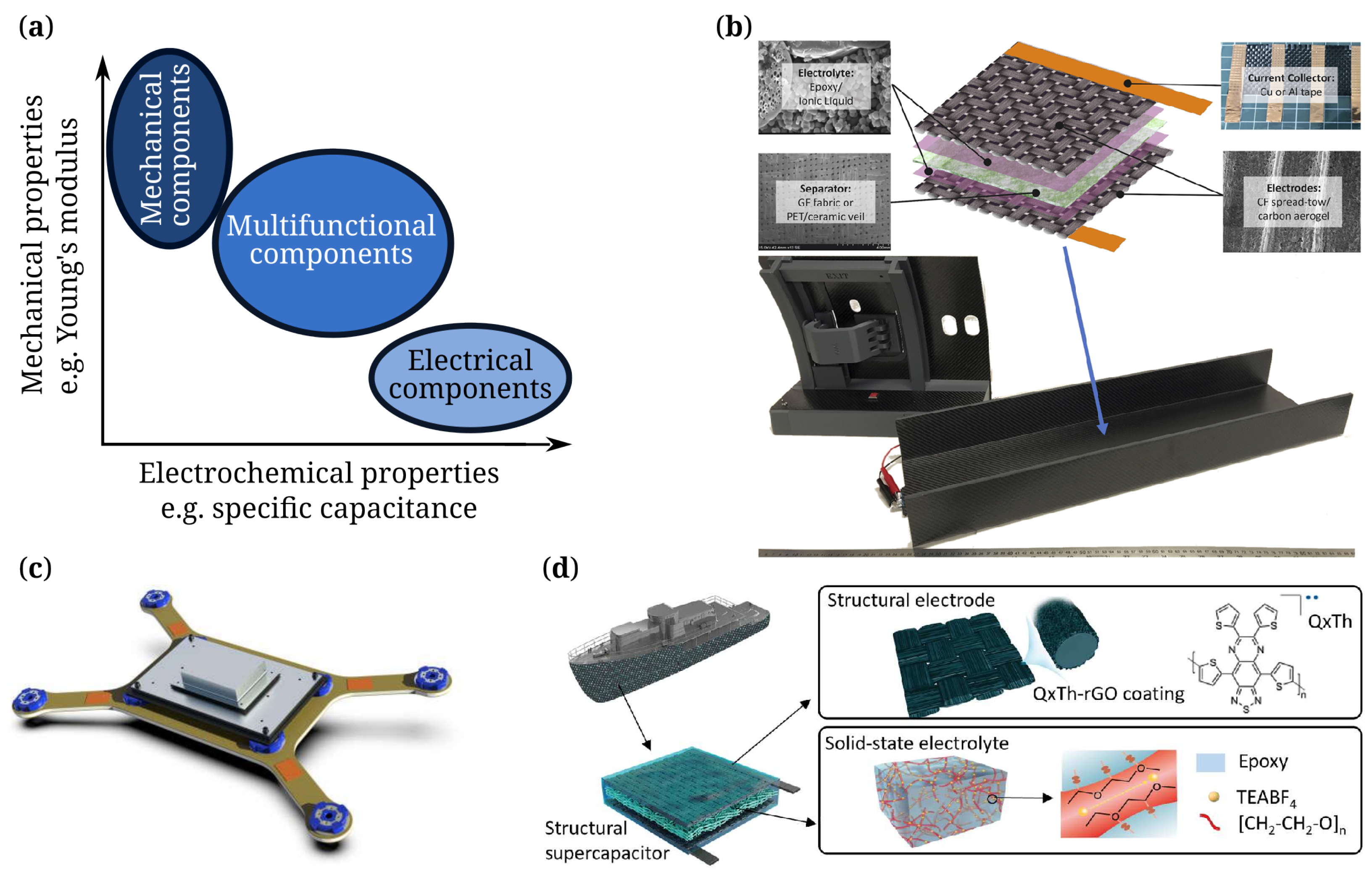
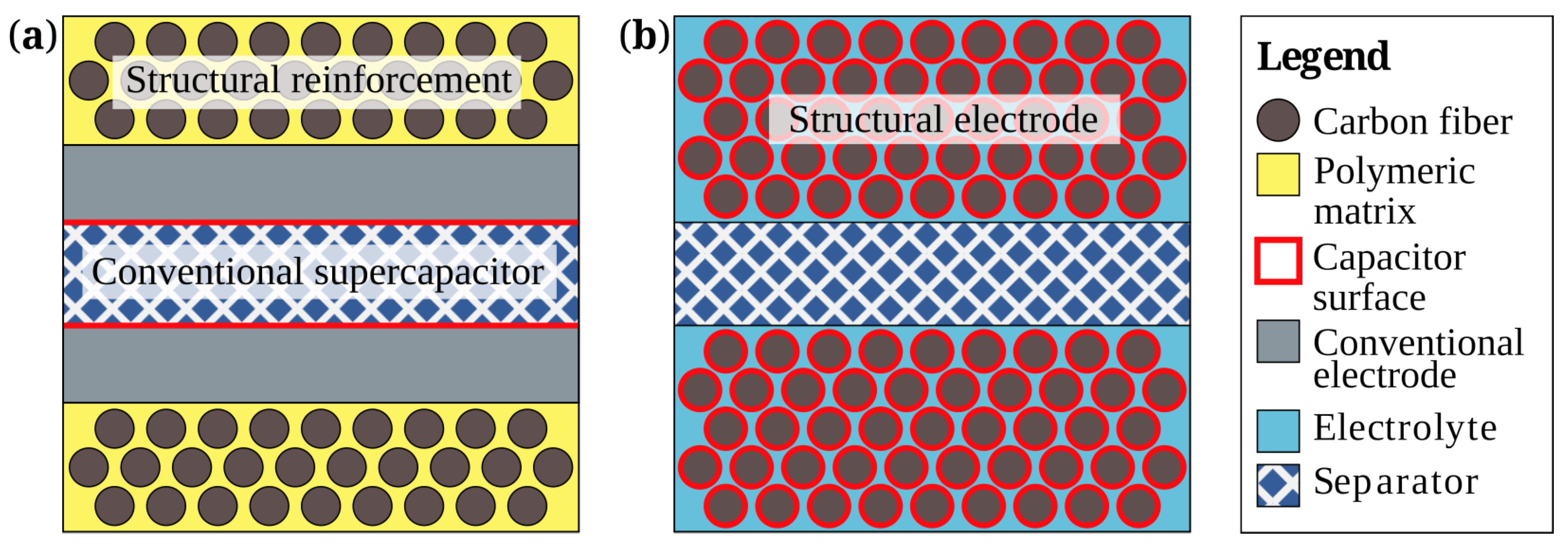

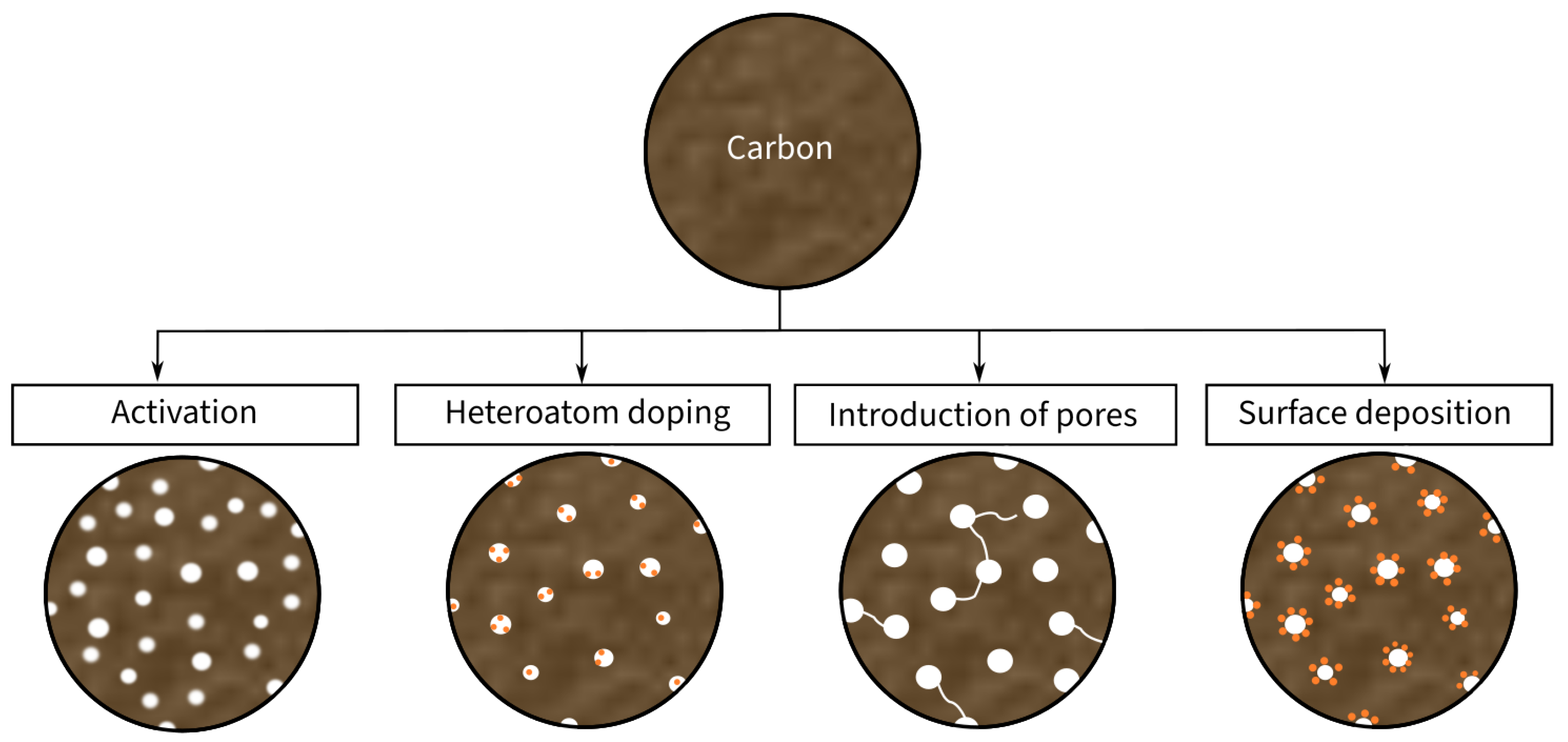
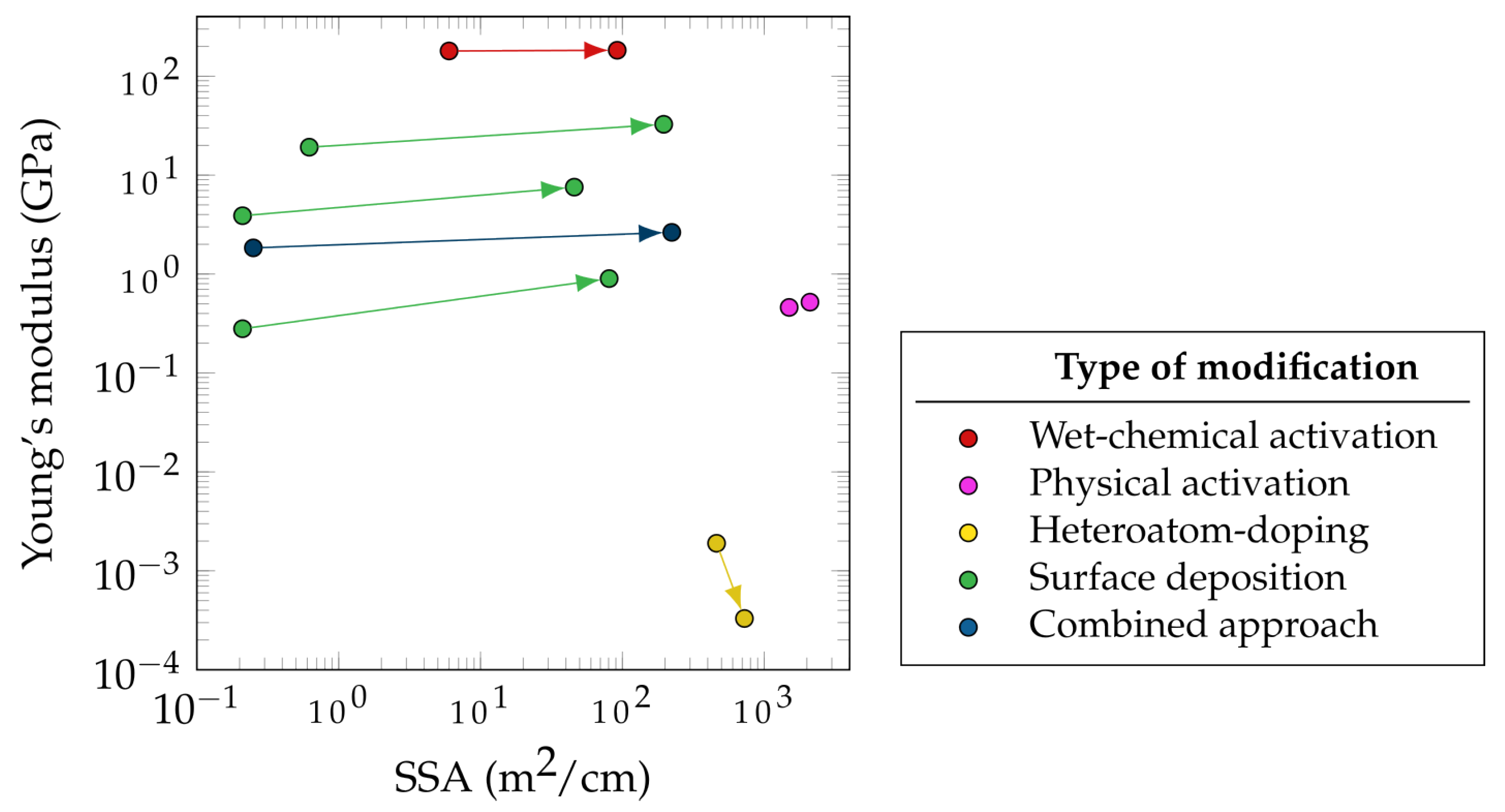
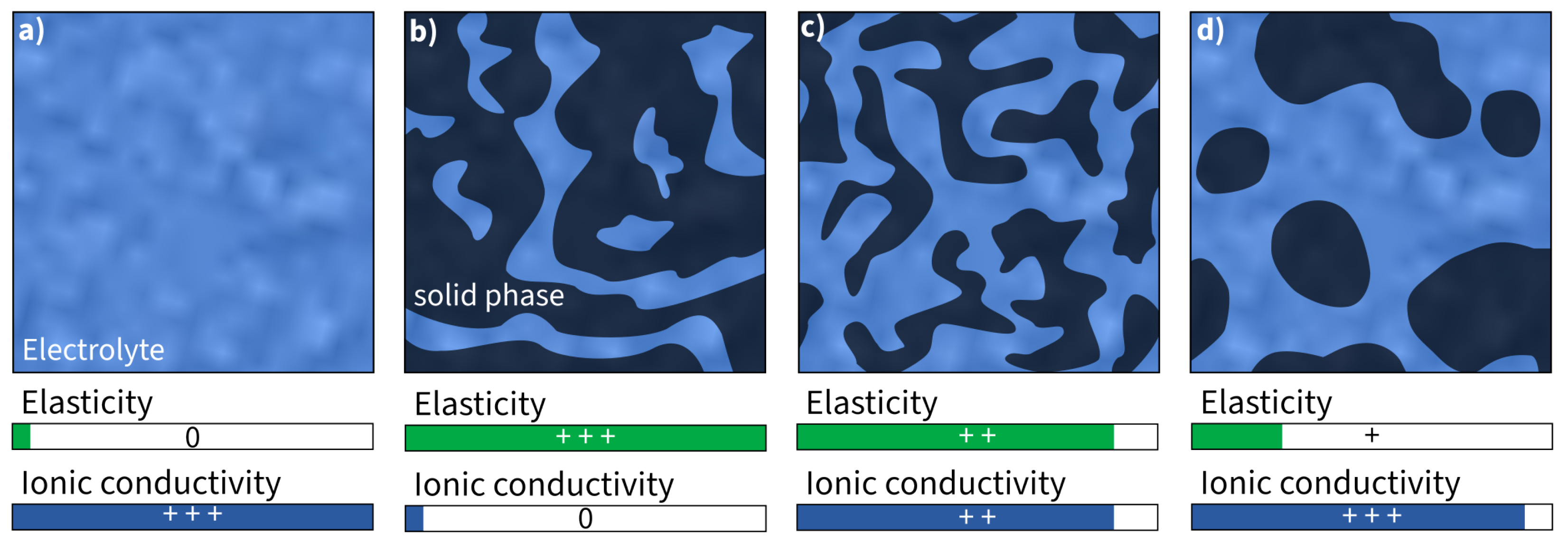
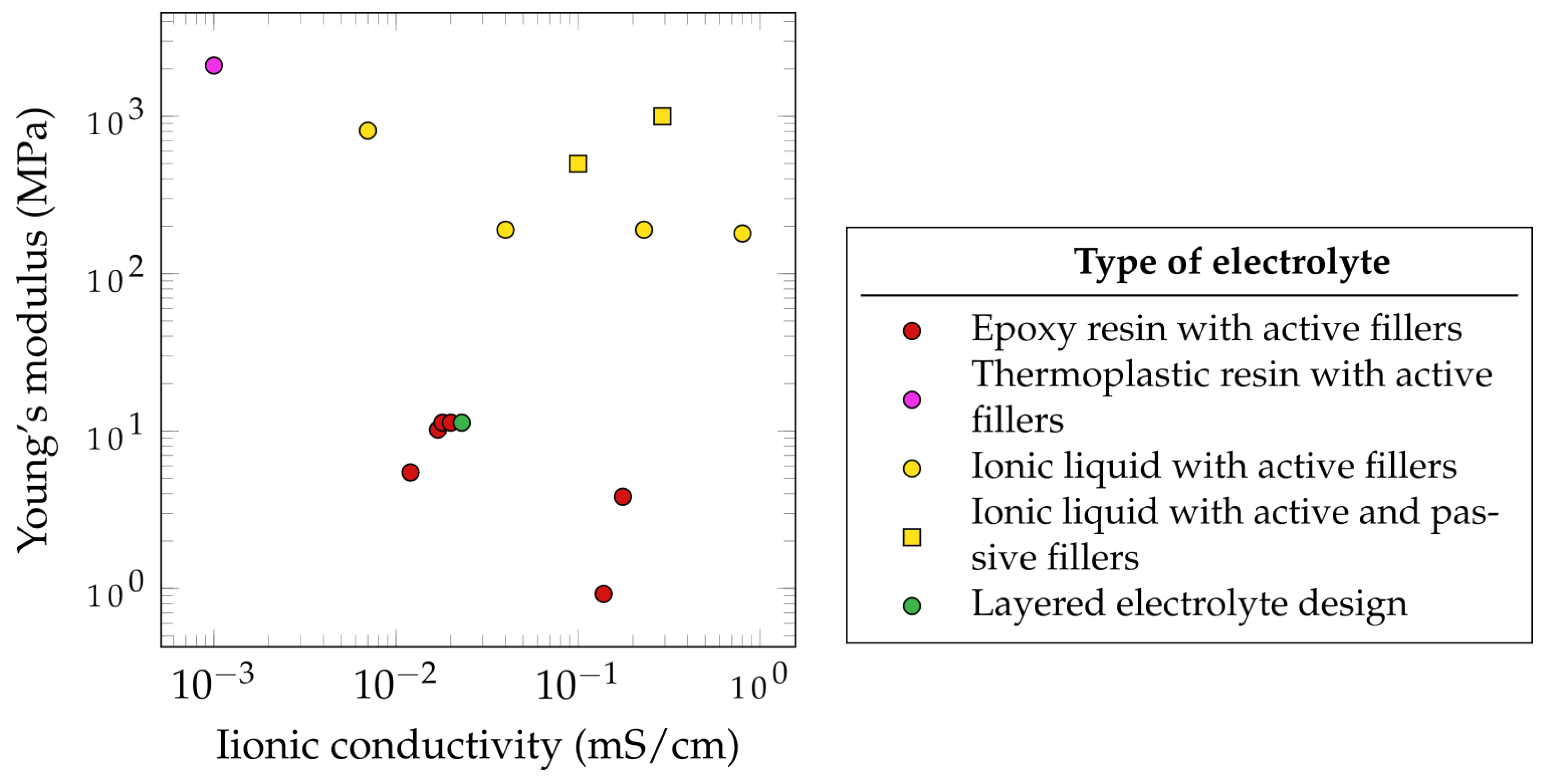

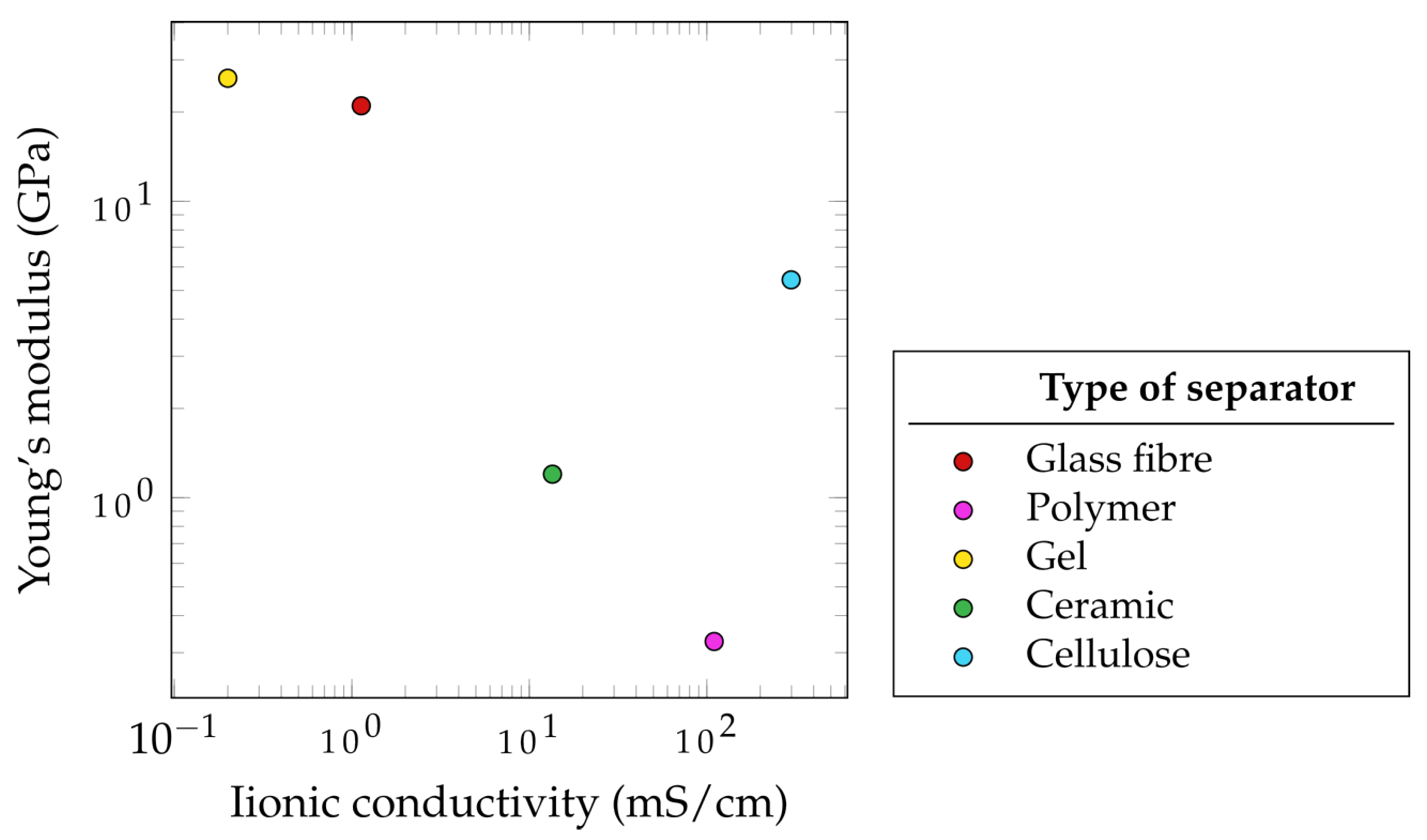
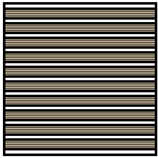 | 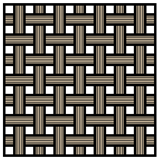 | 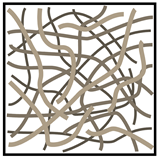 | |
|---|---|---|---|
| CF | Unidirectional | Woven | Non-Woven |
| Load bearing capability * | ++ | ++ | + |
| Specific surface area * | + | + | ++ |
| Electric conductivity * | + | + | 0 |
Disclaimer/Publisher’s Note: The statements, opinions and data contained in all publications are solely those of the individual author(s) and contributor(s) and not of MDPI and/or the editor(s). MDPI and/or the editor(s) disclaim responsibility for any injury to people or property resulting from any ideas, methods, instructions or products referred to in the content. |
© 2024 by the authors. Licensee MDPI, Basel, Switzerland. This article is an open access article distributed under the terms and conditions of the Creative Commons Attribution (CC BY) license (https://creativecommons.org/licenses/by/4.0/).
Share and Cite
Zschiebsch, W.; Sturm, Y.; Kucher, M.; Hedayati, D.P.; Behnisch, T.; Modler, N.; Böhm, R. Multifunctionality Analysis of Structural Supercapacitors— A Review. Materials 2024, 17, 739. https://doi.org/10.3390/ma17030739
Zschiebsch W, Sturm Y, Kucher M, Hedayati DP, Behnisch T, Modler N, Böhm R. Multifunctionality Analysis of Structural Supercapacitors— A Review. Materials. 2024; 17(3):739. https://doi.org/10.3390/ma17030739
Chicago/Turabian StyleZschiebsch, Willi, Yannick Sturm, Michael Kucher, Davood Peyrow Hedayati, Thomas Behnisch, Niels Modler, and Robert Böhm. 2024. "Multifunctionality Analysis of Structural Supercapacitors— A Review" Materials 17, no. 3: 739. https://doi.org/10.3390/ma17030739
APA StyleZschiebsch, W., Sturm, Y., Kucher, M., Hedayati, D. P., Behnisch, T., Modler, N., & Böhm, R. (2024). Multifunctionality Analysis of Structural Supercapacitors— A Review. Materials, 17(3), 739. https://doi.org/10.3390/ma17030739







